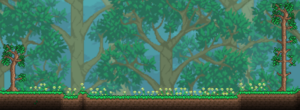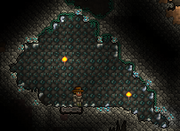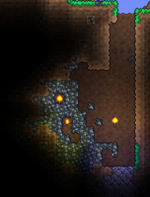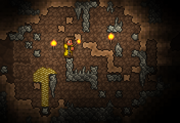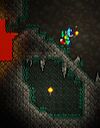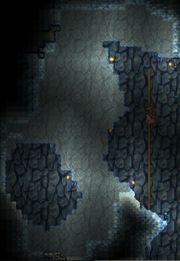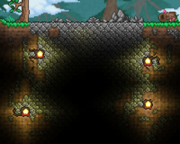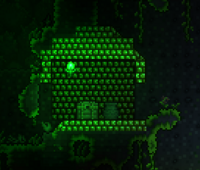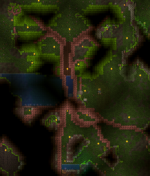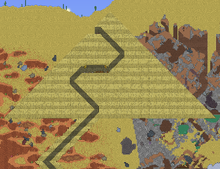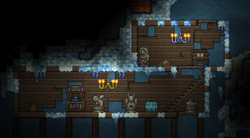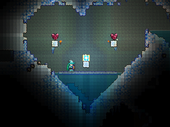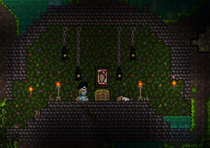Biomok
A Biomok azok a különböző típusú területek, amelyeket bármelyik Terraria világ tartalmazhat. Minden biomnak megvannak a maga jellegzetes blokkjai, gyűjthető tárgyai, hátterei, ellenségei, lényei, tematikus zenéi, háttérfalai, és egyéb jellemzői.
A világ mennyezetét az Űr biom keretezi. A felszíni réteg biomjai a következők: Erdők, Sivatagok, a Havas biom, Esőerdő, Kazamata, a gonosz biom (azaz a Romlottság vagy a Bíbor), és a világ túlsó végén a két Óceán. Ezek a felszíni biomok benyúlnak a Földalatti rétegbe.
Ha a játékos mélyebbre megy, a legtöbbjükből egyedi földalatti variánsokat talál. Ezek közé tartozik a Földalatti sivatag, a Jég biom és a Földalatti esőerdő. A Világító Gomba biom szintén megjelenik a Barlang rétegben, az Alvilág pedig a világ teljes alsó részét elfoglalja.
A Nehézmód aktiválása után néhány új biom jön létre. A világ gonosz biomja mélyebbre hatol a Földalatti Romlottság/Bíbor biomokkal, és kialakul a Szentség és a Földalatti Szentség is.
A Romlottság, a Bíbor és a Szentség mind "fertőző" biomok, amelyek átterjednek bizonyos szomszédos blokkokra. A Nehézmód előtti világban a gonosz biomok csak a fű, jég, homok és kő segítségével érnek el más biomokat, de amint a Nehézmód elkezdődik, mindhárom biom közvetlenül a legtöbb talaj blokkon, szőlőn és tüskés bokrokon keresztül is terjedhet.
A következő rész nincs vagy csak részlegesen van lefordítva
Űr
Space is the layer that appears at the top of the world. The sky is dark, and even if the sun is still up, the stars are visible. Gravity is decreased in Space. Harpies spawn here from the start of the game, and Wyverns, Fősárkánygík![]()
, and Marsi szonda
![]()
![]()
![]() during Hardmode.
during Hardmode.
Felszíni és földalatti
Below Space are the Surface and Underground layers, separated by the 0 feet line. Biomes usually span both of these layers, and their actual "underground" versions do not begin until the depths of the Cavern layer.
Erdő
Forests are the most common surface biomes, and are where the player usually spawns upon starting a new world. Green grass grows across the dirt, which can spawn Mushrooms, Dayblooms, and trees. Forests appear whenever no other biome is valid.
Havas biom
The Snow biome is a winter-themed biome predominately made of Snow and Ice Blocks. Snow falls constantly, though this is only an aesthetic effect. Relative to the world's horizontal center, the Snow biome is always located on the same side as the Dungeon and on the opposite side of the Jungle.[1]
Sivatag
Deserts are large expanses of Sand. Their vegetation is comparatively sparse, consisting solely of Cacti.
Romlottság és Bíbor
A world will always generate with an evil biome – either Crimson or Corruption, but never both (unless in drunk world![]() ). There is a
). There is a 50*1/2 (50%) chance of either of the evil biomes generating, ![]()
![]() although it can be selected manually upon world creation (
although it can be selected manually upon world creation (![]()
![]() provided the Wall of Flesh has been in a separate world before). The evil biomes are hazardous biomes with mostly analogous contents:
provided the Wall of Flesh has been in a separate world before). The evil biomes are hazardous biomes with mostly analogous contents:
- The Corruption follows a rotten theme and features vertical chasms, Shadow Orbs, and Demon Altars.
- The Crimson follows a gory theme and features angled passages, Crimson Hearts, and Crimson Altars.
Esőerdő
The Jungle is composed of Jungle grass, vines, Mud, Bamboo and Mahogany trees. The sky appears a vibrant green color. Mahogany trees regrow automatically without the need to plant Acorns. Relative to the horizontal center of the world, the Jungle is always located on the opposite side of the Snow biome and the Dungeon,[1] and the same side as the Underground Desert.
Kazamata
The Dungeon is a labyrinth leading from the Surface down to near-Underworld depths. The Old Man stands at the entrance, and using him to defeat Skeletron is required to gain access to the inside. Heading below 0 feet in the Dungeon without defeating Skeletron spawns one or more Dungeon Guardians, which have enormous defense and are capable of one-hitting even endgame players. The loot found in the Dungeon is rare, valuable, and much of it cannot be found elsewhere. Relative to the world's horizontal center, the Dungeon is always located on the same side as the Snow biome and on the opposite side of the Jungle.[1]
Óceán
Oceans consist of a deep body of water where dangerous swimming enemies are found and Water Chests which contain ocean-themed loot. They are always located on both horizontal edges of the world. Duke Fishron can be summoned here with a Truffle Worm. The Magic Conch![]() can be used to teleport the player to an Ocean.
can be used to teleport the player to an Ocean.
Világító Gombák biom
The surface version of the Glowing Mushroom biome does not occur naturally, and can only be cultivated by players using Mushroom Grass Seeds or an imported Clentaminator with Dark Blue Solution on surface-level Mud Blocks.
Barlang
The Cavern layer marks the beginning of distinct underground biome variants, with separate characteristics from their surface versions.
Jég biom
The Ice biome is the Cavern layer's more dangerous portion of the Snow biome and is located beneath the surface part. Many ledges and bodies of water will have a layer of Thin Ice over them, and while these can support the player's weight they can break when landing on them with high enough speed. Frozen Chests contain ice-themed equipment.
Földalatti sivatag
The Underground Desert is located beneath the surface Desert. The biome always has either a circular or an oval shape and contains various types of Antlions as well as Hardmode enemies themed after ancient Egypt.
Földalatti esőerdő
The Underground Jungle is located beneath the surface Jungle. Its dense catacomb of compartments contain several hazards and dense vegetation. In Hardmode, the valuable Chlorophyte Ore can be mined here. Three bosses can be fought in this biome: An Underground Jungle always contains several Bee Hives, where the Queen Bee boss is usually summoned. After the mechanical bosses have been defeated, Plantera's Bulbs spawn, allowing the player to summon Plantera. The Jungle Temple is also located within the Underground Jungle, where the Golem boss can be summoned after Plantera is defeated.
Földalatti gomba
The Underground Glowing Mushroom biome features Glowing Mushrooms on top of Mud Blocks, and if there is enough height in the cavern, Giant Glowing Mushrooms can grow as well. It is the only place where Truffle Worms can be obtained.
Földalatti
The Underworld spans the entire bottom of the world. Lava pools cover much of its terrain and dangerous enemies spawn frequently. Hellstone can be mined here, Ruined Houses offer valuable loot (some within their Shadow Chests), and unique furniture, and the Wall of Flesh boss can be summoned here in order to activate Hardmode. In Hardmode, the Megkínzott lélek![]()
![]()
![]() spawns in the Underworld, which can be converted to the Adószedő
spawns in the Underworld, which can be converted to the Adószedő![]()
![]()
![]() NPC using Purification Powder.
NPC using Purification Powder.
Nehézmód
Hardmode biomes spawn or convert as a result of the game transitioning to Hardmode.
A Szentség
The Hallow can be considered the counterpart to the evil biome. It is automatically created once the player activates Hardmode by defeating the Wall of Flesh, and has pastel-colored fairy-tale imagery.
Földalatti Szentség
The Underground Hallow is located beneath the surface Hallow, starting at the Cavern layer. It has a different soundtrack from the surface Hallow, and contains different enemies as well as valuable items, such as Souls of Light and Crystal Shards.
Földalatti Romlottság
The Underground Corruption is created in the Cavern layer upon defeating the Wall of Flesh. It is not necessarily located beneath pre-Hardmode surface Corruption biomes. While it shares the theme with the surface Corruption, it has different enemies and a different soundtrack (a mix of the regular Underground and Corruption soundtrack). It is the only place where enemies drop Cursed Flames. It and the Underground Crimson are the only places to obtain Souls of Night, which are occasionally dropped by all enemies.
Földalatti Bíbor
The Underground Crimson is the alternative to the Underground Corruption, which functions and generates in mostly the same way. The Underground Crimson, like the Corruption variant, will have enemies occasionally drop Souls of Night. It is the only place where enemies drop Ichor.
Romlottság, Bíbor és Szentség Sivatag
When the world enters Hardmode, several Deserts of the world will become either Corrupted, Crimsoned, or Hallowed. These spawn unique versions of the Mummy and Homokcápa![]()
![]() with unique drops. Sand is replaced by Ebonsand, Crimsand, or Pearlsand. It is possible for a pre-Hardmode world to be generated with a Corrupted or Crimson Desert.
with unique drops. Sand is replaced by Ebonsand, Crimsand, or Pearlsand. It is possible for a pre-Hardmode world to be generated with a Corrupted or Crimson Desert.
Romlottság, Bíbor és Szentség Jég
When the world enters Hardmode, the Corruption, Crimson, and Hallow can spread through the Ice biome, generating Purple, Red, and Pink Ice Blocks, respectively. Pigrons of the respective color start to spawn in these areas.
Mini-biomok
Biomes in this category tend to be small in number and size. They generally have unique characteristics and enemy or critter spawns, but usually have neither unique backgrounds nor music.
Méhkaptár
Bee Hives are located in the Underground Jungle. They are made from Hive blocks and contain honey and often a Larva. Destroying the Larva summons the Queen Bee boss. Breaking a Hive block may spawn a Bee and/or some honey.
Gránit barlang
Granite Caves are cave areas made completely of Granite Blocks, usually fairly spacious with interspersed ledges and platforms. They contain granite-themed enemies such as Granite Elementals and Granite Golems.
Márvány barlang
Marble Caves are cave areas that are horizontal in shape and made completely out of Marble Blocks. They contain ancient-Greek-themed enemies such as Hoplites and Medusas.
Temető
Graveyards appear around large clusters of Tombstones. They generate Ecto Mist and spawn enemies such as Ravens, Ghosts and Maggot Zombies, as well as spawn the typical nighttime enemies, even during the day. These are not generated with the world, but are produced by the player(s)... not always on purpose!
Oázis
The Oasis is a mini-biome that spawns in the Desert. It consists of palm trees surrounding a pool of water where cattail plants grow, attracting Dragonflies. If the player places enough water in the Desert, it will become an Oasis.
Világító moha biom
The glowing moss biome is located in the Caverns level of the world, but cannot be found under the spawn area. Nearly every piece of Stone Block is covered in Krypton, Xenon or Argon Moss and every instance found in a single world will use the same moss variant. This mini-biome is much larger than the Moss chamber. There can be up to two to four instances of this biome, depending on world size, though there is no guarantee that any are generated. There are no unique enemies in glowing moss biomes.
Dzsungeltemplom
The Jungle Temple is a large, nearly impenetrable structure that spawns deep in the Underground Jungle. It is filled with powerful enemies and is generally only accessible after defeating Plantera, using the Temple Key she drops to open the door. In the largest chamber, there is a Lihzahrd Altar to spawn Golem with a Lihzahrd Power Cell.
Meteorit
The Meteorite biome is sometimes generated after the player ![]() defeats the Eater of Worlds or Brain of Cthulhu /
defeats the Eater of Worlds or Brain of Cthulhu / ![]()
![]()
![]()
breaks a Shadow Orb or Crimson Heart. There is a
50*1/2 (50%) chance that within the next day at midnight the game will spawn a Meteorite, converting an area of the Surface into a crater with three layers. Blocks in the innermost area will be deleted without dropping anything; surrounding this, all blocks around the empty area will be converted into Meteorite ore; and in a much larger radius outside this mass of ore, only occasional blocks similarly converted. Meteorite ore will afflict the player with the Burning debuff on contact, unless they either have an accessory to nullify its effects, or are under the effect of an Obsidian Skin Potion. Mining Meteorite requires 50% pickaxe power, i.e. a Tungsten Pickaxe, Gold Pickaxe, or better is mandatory. Meteor Heads ( and, in Hardmode, Lava Bats) override all native enemies of the biome the meteor crashed into.
Pókbarlang
Spider Caves are characterized by black background walls and numerous webs filling the area. This mini-biome will spawn Wall Creepers in pre-Hardmode and Black Recluses during Hardmode. The Cobwebs rapidly grow back, which is a unique feature of the biome. Spider Caves are the only location where Web Covered Chests are found, and therefore the only place to obtain a Web Slinger. The Stylist NPC is found in this mini-biome.
Város
A Town is a player-created mini-biome that can be made by having three or more NPCs in close proximity. In Normal mode, they negate enemy spawn rates entirely; even in Expert and Master mode they will sharply reduce enemy spawns. However, enemy spawns are not affected when an event is occurring.
Mikro-biomok
These biomes have unique tiles or structures, but are very small and have no other exclusive properties.
Táborhely
Campsites are found in the Underground and Cavern layers, usually containing a Campfire, a few Silver / ![]() Gold Coin Piles, and a background object of skeletal remains. The campsite is 12–20 blocks wide, and not quite as tall.
Gold Coin Piles, and a background object of skeletal remains. The campsite is 12–20 blocks wide, and not quite as tall.
Virágfolt
Flower patches are small patches of Surface ground densely populated by flowers.
Drágakő barlang
Gemstone caves are filled with concentrated gem deposits of one or more varieties and feature a unique background (a gemstone wall) that is speckled with gems of the same color found in the gemstone cave.
Nagy érc ér
Large ore veins are located at the surface layer and consist of a large vein of Copper/Tin or Iron/Lead Ore buried near the ground, with a few ore blocks above it.
Mozaik
Mosaics are found in the Underground and Cavern layers, consisting of a small room with tiles randomly set inside, with a pile of gold coins in it.
Mohakamra
Moss chambers are very small chambers located in the Underground and Cavern layers that contain one color of moss with a matching back wall.
Vékony jégfolt
Thin Ice patches are micro-biomes found in the Ice biome that are made entirely of Thin Ice and occasional ore veins.
Kőfolt
Stone patches are small patches of ground made of stone found at the surface, consisting of Stone Blocks with matching ambient objects on the top.
Kincses szobák
Treasure rooms are spawned upon world creation and appear as if they were man-made structures. They generally contain loot and furniture.
Elvarázsolt kard szentélye
Enchanted Sword Shrines house an Enchanted Sword, a ![]() Terragrim /
Terragrim / ![]()
![]()
![]() Arkhalis, or a fake sword. Every shrine will contain one breakable background sword sprite, which has a
Arkhalis, or a fake sword. Every shrine will contain one breakable background sword sprite, which has a 66.67*2/3 (66,67%) chance of being a fake sword and a 33.33*1/3 (33,33%) chance of being a real sword, which has a 10*1/10 (10%) chance of dropping the Terragrim/Arkhalis instead of the Enchanted Sword when destroyed.
Lebegő Sziget
Floating Islands are independent masses of land in the sky. They contain a Skyware Chest with valuable loot like the Starfury sword, the Shiny Red Balloon, the Fledgling Wings, or ![]()
![]()
![]()
![]()
a Lucky Horseshoe. Deposits of ore can be found sometimes as well. Depending on world size, there are between two and nine Floating Islands in a world.
Lebegő Tó are a variation of Floating Islands and do not contain a Skyware Chest.
Dzsungel szentély
Jungle Shrines are small brick buildings and typically contain only a single Ivy Chest and a light source. They are found in the Underground Jungle and several can appear in one biome.
Élő Fa
Living Trees are huge, thick trees consisting of foreground blocks (as opposed to regular background trees). Cutting the tree yields regular Wood, while the leaves yield nothing. Some Living Trees can be hollow and lead deep underground. There may be rooms containing Living Wood Chests with related loot inside, as well as Living Wood furniture. It is not guaranteed that one will spawn in every world. In 1.4, Gnomes spawn in hollow Living Trees.
Élő mahagóni fa
Living Mahogany Trees are large trees generated in the Underground Jungle. Cutting the tree yields Rich Mahogany wood, while the leaves yield nothing. They always have a hollow trunk, which contains an Ivy Chest.
Piramis
Pyramids are rarely generated in the Desert upon world creation. They are made of Sandstone Bricks and contain a narrow passage. The treasure room is filled with Coin Stashes, vases and a Gold Chest that can contain unique loot. There is also a passage to a cave at the bottom.
Romos ház
Ruined Houses are generated upon world creation in The Underworld in the middle 50% of the Underworld. They are towers with multiple levels, constructed with missing parts for a "ruined" look, from Obsidian Brick or Hellstone Brick. They are sometimes partially submerged in lava and there are often deposits of Hellstone just outside their walls.
Földalatti fülke
Underground Cabins are found in the Cavern layer. They are typically wooden buildings full of dusty, broken furniture as well as Chests, vases, and occasionally usable furniture and decorations. On the ![]() Asztali számítógépes változat,
Asztali számítógépes változat, ![]() Konzolos változat, és
Konzolos változat, és ![]() Mobilos változat, Underground Cabins spawn with blocks representing their biome.
Mobilos változat, Underground Cabins spawn with blocks representing their biome.
If the player patches the holes in the walls and fulfills all NPC requirements, NPCs can move in.
Törölt biomok
The following two biomes were exclusive to the ![]() Mobilos változat, and were removed in the Mobile 1.3.0.7 update.
Mobilos változat, and were removed in the Mobile 1.3.0.7 update.
Szív szentély
Heart Shrines were heart-shaped caves sometimes found in Snow biomes. They held two Crystal Hearts and a Chest that contained heart-themed items for the Valentine's Day celebration event.
Dzsungel szentély
A Jungle Sanctum was a structure that occasionally appeared in the Jungle. Jungle Sanctums were larger versions of Jungle Shrines and contained Coin Stashes, along with an Ivy Chest that contained several Jungle-themed items.
Hibrid biomok
Although many basic biomes appear at the world generation or are triggered by events, hybrid biomes may be synthesized by world mechanics or through player action.
Hybrid biomes are those created by the requirements being met for multiple biomes in a certain area. The simplest examples are Hallowed, Crimson, and Corrupted Deserts; however, not only Deserts can be hybridized. Floating Islands can be Corrupted/Crimsoned or Hallowed upon entry of Hardmode, and such high-layered biomes are even required by some Angler quests. Player action can similarly introduce Corruption, Crimson, Hallow, Desert, Jungle, Mushroom, Meteorite, or Snow biomes to any location from Underworld to Space. This can lead to, for example in an Underworld Crimson, Underworld and Crimson enemies both spawning in the applicable areas.
Biom létezési követelmények
The area used for counting required blocks for the existence of biomes at a location appears to be ![]() 85 /
85 / ![]()
![]()
![]()
50 tiles to each side and approximately
![]() 61 /
61 / ![]()
![]()
![]()
42 below and
![]() 64 /
64 / ![]()
![]()
![]()
44 above, from the location of the player. In the following table, the "Compatible biomes" column lists the biomes which can co-exist in the same general location, and has nothing to do with spreading mechanics.
| Name | Block and location requirements[2] | Compatible biomes |
|---|---|---|
| Erdő | Above the Underworld. | Space, Surface, Underground, Cavern, Ocean |
| Temető | At least 5 |
Not Underground, Cavern, Underworld, Meteorite or Dungeon |
| Romlottság | At least
Each Sunflower increases the requirement by |
Not Forest, Meteorite or Hallow |
| Bíbor | At least
Each Sunflower increases the requirement by
|
Not Forest, Meteorite or Hallow |
| Gomba | At least 100 of the following: | Not Forest or Meteorite |
| Esőerdő | At least
|
Not Forest or Meteorite |
| Szentség | At least
Each Corruption or Crimson block increases the requirement by 1. |
Not Forest, Meteorite, Corruption or Crimson |
| Sivatag | At least |
Not Forest or Meteorite |
| Óceán | At least 1,000 tiles of The lateral location must be within 338 tiles (676 feet)[4][5] from either edge of the map. The vertical location must be above roughly the |
Not Meteorite, Corrupt Desert, Crimson Desert, or Hallowed Desert |
| Hó | At least |
Not Meteorite or Desert |
| Meteorit | At least |
Any |
| Kazamata | At least 250 |
None |
Megjegyzések
- For Hallowed and Crimson/Corruption biome detection: There is a Hallowed value, a Crimson value, and a Corruption value. Each Hallowed block adds 1 to the Hallowed value and subtracts 1 from both the Crimson and Corruption values. Each Crimson block adds 1 to the Crimson value and subtracts 1 from the Hallowed value. Each Corruption block adds 1 to the Corruption value and subtracts 1 from the Hallowed value. This can be proven by placing 125 Hallowed blocks in an otherwise completely neutral area, observing that the area will change to Hallowed on placement of the 125th block, then that it will return to neutral on placement of a Crimson or Corruption block, then back to Hallowed on placement of an additional Hallowed block, ad infinitum.
- For Snow biome detection: While the area functionally changes to a Snow biome at 1,500 related blocks, the background of a Snow biome will not appear until 1,501 Snow biome blocks are present.
- For Glowing Mushroom biome detection: While the area functionally changes to a Glowing Mushroom biome at 101 related blocks, the background of a Glowing Mushroom biome will not appear until 201 Glowing Mushroom biome blocks are present. And the Funkytown achievement requires 200 Glowing Mushroom biome blocks.
- For Dungeon biome detection: The game checks the number of Dungeon blocks (≥250), and checks only the single background wall the player is standing in front of. This wall must be naturally placed, from the original world creation.
- Inactive blocks (actuated blocks) will count towards the formation of a biome.
Apróságok
- There were originally supposed to be alternative biomes for the Jungle, Underworld, and Hallow called Swamp, Hell, and Candyland, respectively, which would have replaced the original biomes in the same way the Crimson occasionally replaces the Corruption. The Hell was going to be based on the Hell from the 1997 American animated musical fantasy movie Hercules. However, these ideas were scrapped as the developers changed direction.[8][9]
 If a supported RGB keyboard and/or mouse is detected, the colors will change depending on the biome the player is in.
If a supported RGB keyboard and/or mouse is detected, the colors will change depending on the biome the player is in.
Történet
- Desktop 1.4.0.1:
- Oasis and Graveyard mini-biomes added.
- Flower patch, stone patch, large ore vein, and mosaic micro-biomes added.
- Campsite micro-biomes can now generate with Gold Coin Piles in place of Silver Coin Piles.
- Number of blocks required to generate a biome increased for most biomes.
- Horizontal scan distance for determining biomes increased to 85 tiles.
- Vertical scan distance for determining biomes increased to 61 tiles below, and 64 tiles above.
- Desktop 1.3.0.1:
- Added Marble and Granite Mini-Biomes
References
- ↑ 1,0 1,1 1,2 Information taken from the
 Asztali 1.4.2.3 source code, method
Asztali 1.4.2.3 source code, method GenerateWorld()Terraria.WorldGen.cs Asztali számítógépes változat is 1.4.4.9.
Asztali számítógépes változat is 1.4.4.9.
- ↑ Information taken from the
 Asztali 1.4.0.5 source code, method
Asztali 1.4.0.5 source code, method UpdateBiomes()Terraria.Player.csExportTileCountsToMain()Terraria.SceneMetrics.cs Asztali számítógépes változat is 1.4.4.9.
Asztali számítógépes változat is 1.4.4.9.
- ↑ 3,0 3,1 Information taken from the
 Asztali 1.3.5.3 source code, method
Asztali 1.3.5.3 source code, method PreRenderPhase()inTerraria.Lighting.cs. There may be inaccuracies, as the current Asztali számítógépes változat is 1.4.4.9.
Asztali számítógépes változat is 1.4.4.9.
- ↑ Players cannot come within 41 tiles from the absolute edge of the map. Thus, from a player's perspective, the oceans end roughly 338 tiles (686 feet) from either lateral end, but technically they actually end 380 tiles (760 feet) from either end. Information taken from the
 Asztali 1.4.0.5 source code, method
Asztali 1.4.0.5 source code, method BordersMovement()inTerraria.Player.cs. There may be inaccuracies, as the current Asztali számítógépes változat is 1.4.4.9.
Asztali számítógépes változat is 1.4.4.9.
- ↑ 5,0 5,1 Information taken from the
 Asztali 1.4.0.5 source code, method
Asztali 1.4.0.5 source code, method oceanDepths()inTerraria.WorldGen.cs. There may be inaccuracies, as the current Asztali számítógépes változat is 1.4.4.9.
Asztali számítógépes változat is 1.4.4.9.
- ↑ On
 Asztali, the Ocean vertically ends at a point 40 tiles (80 feet) deeper than the middle of the Underground layer. On
Asztali, the Ocean vertically ends at a point 40 tiles (80 feet) deeper than the middle of the Underground layer. On  Konzol,
Konzol,  Mobil, és
Mobil, és , the Ocean vertically ends at a point 10 tiles (20 feet) deeper than the start of the Underground layer – i.e. ending at a depth of approximately 23 feet, as shown by a Depth Meter.
- ↑ Note that the requirement for naturally-placed walls makes a synthetic Dungeon biome nearly impossible and, if accomplished, it would be unable to spawn Hardmode Dungeon enemies or Cursed Skulls (as they require naturally-placed Dungeon Brick Walls), though it may be useful for creating a lake for farming Dungeon Crates. It appears that the only option for expanding the space in which Hardmode Dungeon enemies can spawn is by mining blocks already inside the area in which the Dungeon originally generated, without damaging any naturally-placed walls they are covering.
- ↑ Cenx: "We had several biomes we started designing that were scrapped as we changed direction. Before the Jungle became the massive beast it is today Jimmarn had started designing sprites for a Swamp Alternative. We also had concepts for a Candyland version of the Hallow and ideas for a Hell alternative based on the color schemes from the Hell in Disney's Hercules."
Terraria's 8th Anniversary - Ask Redigit and Cenx! May 20, 2019 - ↑ Terraria's 10th Anniversary: We are Re-Logic, Ask Us Anything! May 17, 2021
- Pages using DynamicPageList3 dplvar parser function
- Pages using DynamicPageList3 dplreplace parser function
- Pages with information based on outdated versions of Terraria's source code
- Entities patched in Desktop 1.4.0.1
- Entities patched in Desktop 1.3.0.1
- Environments






























